
Drowning and Resuscitation Pages: 1 2 3 4 5 6 7 Next>>
Resuscutation of Drowning Victims at Sea, Page 2
Could Sailors Swim?
Occasionally you read that many or even all of the sailors couldn't swim during the age of sail. It doesn't make intuitive sense to most people that a sailor couldn't swim, given that his life might depend on that skill. In his book Life at Sea, W.R. Thrower comments with some frustration, "It is often stated that sailor of old usually could not swim because they knew that if they fell overboard it was unlikely that they could be picked up, swimming only prolonged the agony of drowning. I doubt whether this statement is strictly true – perhaps it mainly applied to landsmen forced by the press gang to serve afloat."1 Still, the myth that sailors intentionally didn't posses a skill that would seem essential in many circumstances makes the idea all the more fantastic and fun to repeat.
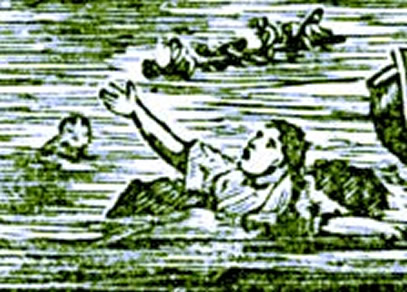
Sailor Struggling -
From Thrilling Narratives of Mutiny, Murder and Piracy
There is certainly evidence that some of the sailors during this time couldn't swim. Edward Barlow reported that a sailor on the ship the Hannibal, drowned by "leaping overboard, and it being out of his depth and he could not swim, and in the beginning of the night and a little dark, he was never seen more"2. On October 10th, 1710, privateer captain Woodes Rogers wrote that, "This Morning in Stowing our best Anchor, Joseph Long, a Sailor, fell over Board, and being no Swimmer, before we could get the Boat out to his Assistance, was lost."3
However, others could swim, although not very well. When one of pirate captain Edward Low's ships overturned during a careening, captured fisherman Philip Ashton wound up in the water. "I (who was with other light Lads [who] were sent up to the Main-Top-Gallant Yard [to set the ship upright again]) was very difficultly put to it to save my Life, being but a poor Swimmer"4.
In 1702, Francis Rogers reported that he couldn't swim in a marginal note in his journal, although he had earlier written that "I was overboard a-swimming but had like to have paid dear for it, for I had but just got into the ship again, when (there) appeared a shark ranging alongside for what he could get"5. This suggests he may have been able to swim to some degree.
In 1678, Henry Teonge gave an account of gunner John Rose who could apparently "swim very well" but when he went into the water "instead of
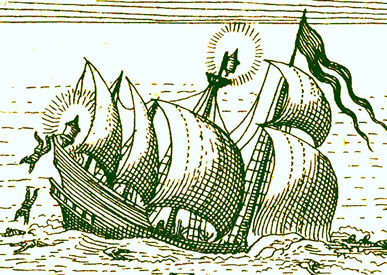
Artist: Paul Jacobi
From Historische Beschreibung der Wunderbarlichen Reyse, plate 9 (1619)
swimming he could only paddle in the water like a dog, and was immediately drowned."6 Teonge's narrative makes it unclear whether Rose was truly a good swimmer or the dog-paddling was a jibe at a fellow, non-swimming sailor whom Rose said was not as good as a dog if he couldn't swim. If his motivation to dog-paddling was to taunt a fellow sailor, he clearly took the joke too far.
Yet other accounts insist that some sailors could swim. When Jeremy Roch wrote about the overloaded boat overturning near their ship (given in the section on shipwrecks), he explained that "some [of those in the boat] swam, others held by oars; boards and other things [which] were thrown out to them."7
Also mentioned in a previous section, when the ship Edward Coxere was on caught fire "the men which could swim leapt over board into the sea to swim to the boats that were at the stern of our ship"8 Further proof of swimming sailors comes from Edward Barlow's warning that "in some places men, as they have been swimming for recreation, have had their legs bitten off and also have been carried quite away and never seen more, so that great heed must be taken to them when anyone is swimming where any of these fish are"9. While they may not have been able to swim after the shark attack, they were at least able to do so before it.
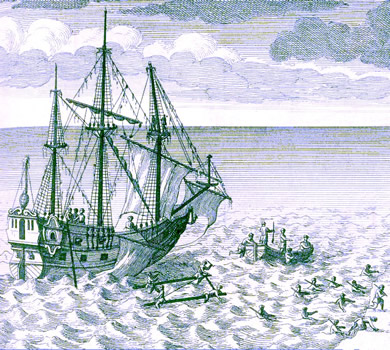
Artist: Claude-Charles LeRoy
Men Swimming to Shore From Histoire de l'Amerique Septentrionale (1722)
If some sailors could swim, so could some privateers and pirates. Privateer William Dampier explained that he "carried a large Joint of Bambo, which I stopt at both Ends, closing it with Wax, so as to keep out any Water. In this I preserved my journal and other Writings from being wet, tho’ I was often forced to swim."10 While giving the history of future pirate captain David Williams, Charles Johnson notes that, "The captain manned and sent ashore the long-boat to seek for water, but a large surf running, she came to an anchor, at some little distance from shore, and David Williams, with another, being good swimmers, stripped and swam off in search of water."11
Looking at all these accounts, it can be seen that some sailors during this time couldn't swim, some could swim, but not well and others could swim just fine. Although swimming was apparently not a required skill for a sailor at this time, the above quotes reveal that it would be a valuable one to have. In his account of the privateering voyage of the Duke and Dutchess, Woodes Rogers notes in 1710 that "Thomas Conner, a Boy, fell overboard, but the Launch being a-stern, we cut her Moarings, and took him up just as he was tired with Swimming, and ready to sink."12 This skill certainly stood young Thomas well.
However, as John Wilkinson put it, "art can give succour to nature, and even that is but for so short a time, that the strongest, most expert swimmer, soon expires in the billows of a tempestuous sea."13
1 William Rayner Thrower, Life at Sea in the Age of Sail. p. 26; 2 Edward Barlow, Barlow’s Journal of his Life at Sea in King’s Ships, East and West Indiamen & Other Merchantman From 1659 to 1703, p. 189; 3 Woodes Rogers, A Cruising Voyage Round the World, p. 215; 4 Philip Ashton. A History of the Strange Adventures and Signal Deliverances of Mr. Philip Ashton Jun. of Marblehead, p. 29; 5 Bruce S. Ingram, Three Sea Journals of Stuart Times, 1936, p. 150; 6 Henry Teonge, The Diary of Henry Teonge, Chaplain on Board H.M.’s Ships Assistance, Bristol, and Royal Oak, 1675-1679, p. 213-4; 7 Ingram, p. 66; 8 Edward Coxere, Adventures by Sea of Edward Coxere, p. 7-8; 9 Barlow, p. 83; 10 William Dampier, Memoirs of a Buccaneer, Dampier’s New Voyage Round the World -1697-, p. 21; 11 Captain Charles Johnson, The History of the Pirates, p. 167; 12 Rogers, p. 190; 13 John Wilkinson, Tutamen Nauticum or The Seaman's Prevention from Shipwreck, Diseases and Other Calamities Incident to Mariners, Part 1, p. 1
A Man Overboard!
"But the cry of fire on shore is nothing to be compared with the cry of a man overboard at sea. ...when the cry of a man overboard is heard, he [the sailor] springs from his hammock instantly, mounts on deck, flies to the boat, eager to be one of the foremost in saving a life." (Nauticus, "A Man Overboard", The Naval and Military Magazine, Volume 2, Sept. 1827, p. 99)

Artist: William Joy
A Royal Naval Two-Decker Heaving-to to
Pick Up a Man Overboard (mid_18th c.)
When a man went overboard, the men on a ship did their utmost to retrieve them. In 1841, Richard Henry Dana published a procedure for handling a situation where a man had inadvertently gone into the water.
A Man Overboard* — The moment the cry is heard, put the helm down and bring her up into the wind, whether she is on the wind or free, and deaden her headway. [Slow the ship.] Throw overboard instantly life buoys, or, if there are none at hand, take a grating, the carpenter s bench, or any pieces of plank or loose spars there may be about decks; and let two or three hands clear away a quarter boat...
Lower away the boat as soon as it is safe, and, as the vessel will have turned nearly round [by setting the sails so that this occurs], direct the boat with reference to her position when the accident happened and her progress since.1
Of course, Dana was writing more than 100 years after the golden age of piracy, meaning some of the details of his explanation
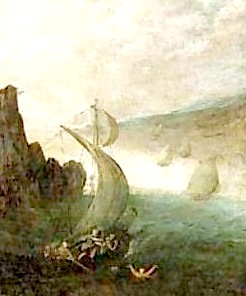
Artist: Lodovico Pozzoserrato
Fishermen Retrieve a Man Overboard (16th c.)
might not be wholly appropriate. For example, there were no life buoys as we know them in the early 18th century. However, throwing something that floated to a man in the water seems a natural thing to do and was done in at least some cases.
The excerpt from Jeremy Roch's journal cited previously, explained that some of the men who fall out of the pinnace grasped "oars; boards and other things [which] were thrown out to them."2 Lieutenant Archer of the man-of-war Phoenix gives an account of rescuing a man fallen in the Caribbean during a hurricane in 1780 which reveals that "the boy who was at the helm, left it to throw something overboard"3 to the man in the water while a more seasoned sailor went about slowing the ship down in preparation for a rescue.
Edward Barlow gives multiple accounts of men going overboard and being 'drownded' without giving details of how or even if they tried to recover the men.4 However, Barlow does provide some detail of what happened in another case in 1672. As Barlow explains, "it [was] blowing pretty hard and some of our men going up into the foretop to reef our fore topsail [reduce its size to increase stability of the ship], a young youth fell from the fore topsail yard into the sea, and was drowned, yet he could swim pretty well, but the ship driving away, and hoisting out ye boat, and it blowing very hard, the boat looked for him but could not find him, for the waves running high had swallowed him up and he was lost."5 Although the boy drowned, we can at least see that they must have slowed the ship so that they could put out a boat to search for the unfortunate lad, just as Dana explained.
Even pirates knew the man overboard drill. A story told about pirate captain John Smith (aka Gow) in the third edition of
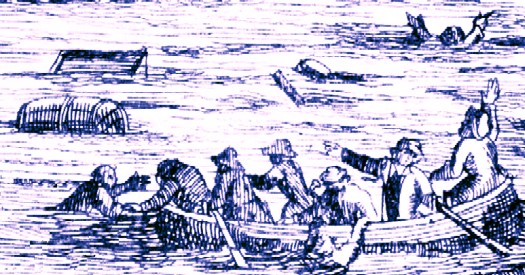
Rescuing People From the Sea, Taken From The Christmas Flood (1717)
A General History of the Pirates says that when they mutinied aboard the George Galley, his crew used the cry to further their aims.
The first Alarm was given, by crying out, That a Man was tumbled overboard. This brought the Captain to the Ships Side, to look after the Man who was supposed to have fallen in the Sea, when he was immediately seiz’d by two of the Conspirators, William Melann [Melvin] and Peter Rolson [Rawlinson], who endavour’d to throw him over and drown him, tho’ at that Instant met with one [James] Winter with a Knife in his Hand, coming up from cutting the Surgeons Throat, with which he also cut his Throat, but missing his Windpipe, the former two took hold of him again, trying to fling him overboard, but he still struggling with them, Smith, the then second Mate, came up, to him, and with a Pistol Shot him thro’ the Body, and then they threw him into the Sea.6
The more generally circulated version of this tale these days leaves out the detail about the alarm created by 'Man overboard' cry.7 Even so, its inclusion in the third edition does reveal the concern about retrieving men fallen overboard in 1725 when it was published.
Although the concern for retrieving a lost man were high, the chances were slim that such a man would be found and retrieved in time to save him. When he was recovered and found nonresponsive, something had to be done to resuscitate him or the efforts to retrieve him would have been to no purpose. Let's look at how that was done.
1 Richard Henry Dana, The Seaman's Manual, p. 78; 2 Bruce S. Ingram, Three Sea Journals of Stuart Times, 1936, p. 66; 3 Lieutenant Archer, "Incidents of Ocean Life", Life and Death on the Ocean, edited by Henry Howe, p. 567; 4 For examples, see Edward Barlow, Barlow’s Journal of his Life at Sea in King’s Ships, East and West Indiamen & Other Merchantman From 1659 to 1703, p. 445-6; 5 Barlow, p. 206-7; 6 Captain Charles Johnson, A general history of the pirates, 3rd Edition, p. 421; 7 In his popular edition of the combined books of Captain Johnson which he "edited, corrected and annotated", Manuel Schornhorn chooses to leave this detail out (see Schornhorn's edition of the General History, page 359). Schornhorn explains in an end note that in the fourth edition of A General History, the author (whom he mis-credits as being Daniel Defoe) "revised his chapter, compressing and excising a good deal of material, and presented the most succinct account of the affair." (p. 681)

